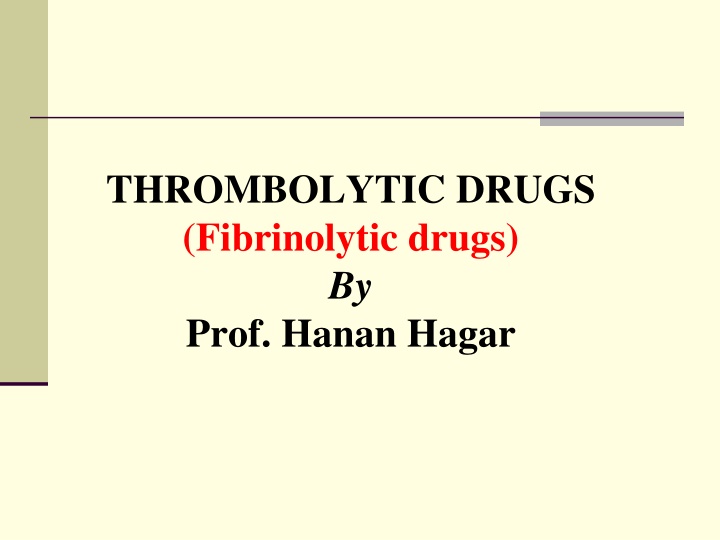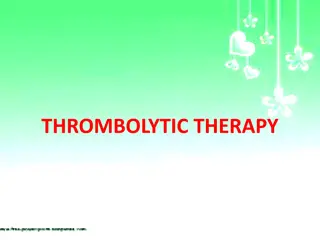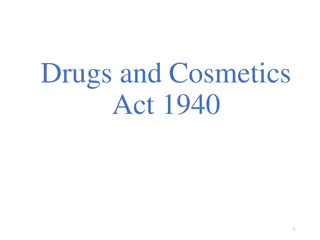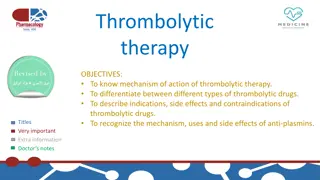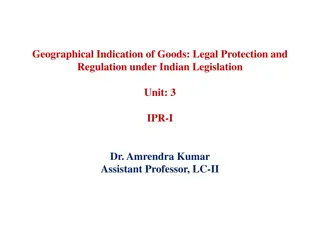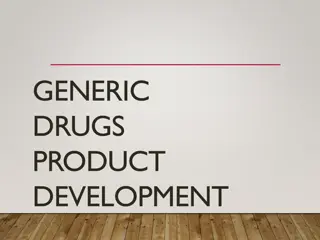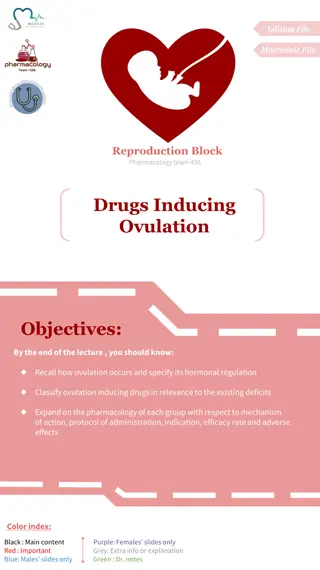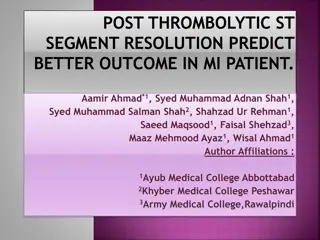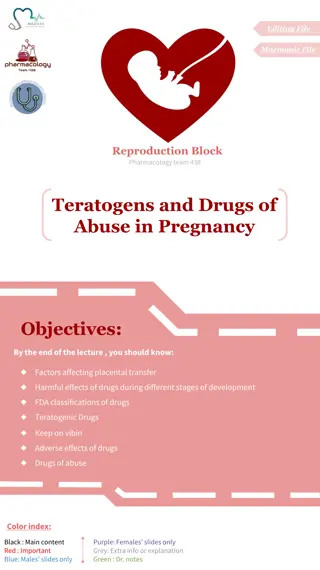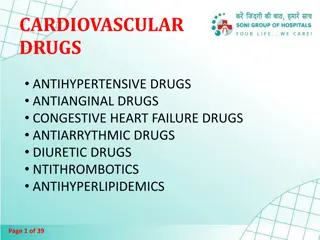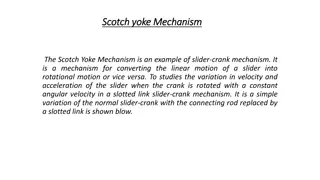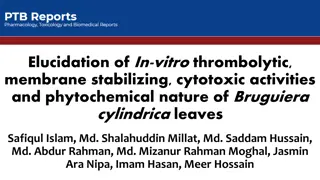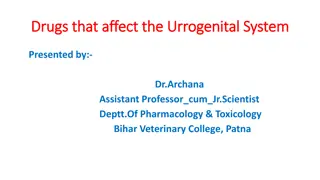Thrombolytic Drugs: Mechanism and Indications
Thrombolytic drugs are used to dissolve blood clots in critical conditions like heart attacks and strokes. Learn about their mechanisms, different types, indications, and potential side effects in clinical settings.
Download Presentation

Please find below an Image/Link to download the presentation.
The content on the website is provided AS IS for your information and personal use only. It may not be sold, licensed, or shared on other websites without obtaining consent from the author.If you encounter any issues during the download, it is possible that the publisher has removed the file from their server.
You are allowed to download the files provided on this website for personal or commercial use, subject to the condition that they are used lawfully. All files are the property of their respective owners.
The content on the website is provided AS IS for your information and personal use only. It may not be sold, licensed, or shared on other websites without obtaining consent from the author.
E N D
Presentation Transcript
THROMBOLYTIC DRUGS (Fibrinolytic drugs) By Prof. Hanan Hagar
Learning objectives To know mechanism of action of thrombolytic therapy. To differentiate between different types of thrombolytic drugs. To describe indications, side effects and contraindications of thrombolytic drugs. To recognize the mechanisms, uses and side effects of antiplasmins.
Definition of Thrombolytics Thrombolytic agents are drugs used to lyse already formed blood clots in clinical settings where ischemia may be fatal.
Mechanism of action of thrombolytic drugs They have common mechanism of action by stimulating activation of plasminogen via converting plasminogen (pro-enzyme) to plasmin (active enzyme) lysis of the insoluble fibrin clot into soluble derivatives.
What is plasmin? Plasmin: is a nonspecific protease capable of breaking down: Fibrin Other circulating proteins including fibrinogen, clotting factor V & factor VIII.
Thrombolytic drugs Plasminogen activators Plasminogen Thrombolytics (Plasminogen activators) Plasmin Soluble degradation products Insoluble fibrin
Indications of thrombolytics used for the treatment of thromboembolic disorders as: Acute myocardial infarction (ST elevation, STEMI). Acute ischemic stroke. Peripheral artery occlusion. Deep venous thrombosis. Pulmonary embolism.
Types of thrombolytic drugs Non-fibrin specific Streptokinase Fibrin specific Tissue plasminogen Anistreplase Activators (t-PA) Urokinase Alteplase Reteplase Tenecteplase
Fibrin specific plasminogen activators Fibrin specific plasminogen activators activate mainly plasminogen bound to clot surface and have less effect on circulating plasminogen. PAI= plasminogen activator inhibitor
Non-fibrin specific plasminogen activators Activate both plasminogen bound to clot surface and circulating plasminogen in blood leading to extensive systemic plasminogen activation, with degradation of several plasma proteins including fibrinogen, factor V, and factor VIII.
Non fibrin-specific thrombolytic drugs Fibrin-specific thrombolytic drugs Activate plasminogen bound to clot surface and circulating plasminogen in blood Degrade fibrin clots as well as fibrinogen and other plasma proteins. Less selective in action activate mainly plasminogen bound to clot surface (fibrin specific) Degrade mainly fibrin clots More selective in action (clot or fibrin specific) Less systemic plasminogen activation Less risk of bleeding Alteplase Reteplase Tenecteplase Extensive systemic plasminogen activation More risk of bleeding Streptokinase Anistreplase Urokinase
Non fibrin-specific thrombolytic drugs e.g. Streptokinase Anistreplase Urokinase activates plasminogen both in blood and at the clot surface thus produces clot lysis and systemic fibrinolysis leading to bleeding.
Fibrin-specific thrombolytic drugs are tissue plaminogen activators e.g. Alteplase Reteplase -Tenecteplase selective in action (clot or fibrin specific) binds preferentially to plasminogen at the fibrin surface (non-circulating) rather than circulating plasminogen in blood. Risk of bleeding is less than non specific agents. Activity is enhanced upon binding to fibrin.
Non fibrin-specific thrombolytic drugs Streptokinase Anistreplase Urokinase
Streptokinase (SK) Is a bacterial protein produced by B-hemolytic streptococci. It acts indirectly by forming plasminogen- streptokinase complex "activator complex" which converts inactive plasminogen into active plasmin. Streptokinase is non-fibrin specific can degrade fibrin clots as well as fibrinogen and other plasma proteins.
Mechanism of action of streptokinase + Streptokinase Plasminogen Activator complex Streptokinase + Plasminogen Plasmin Soluble degradation products Fibrin
Streptokinase T 1/2 = less than 20 minutes. given as intravenous infusion (250,000 U then 100,000 U/h for 24-72 h). It is the least expensive among others. used for venous or arterial thrombosis.
Side effects of streptokinase Antigenicity: high-titer antibodies develop 1 to 2 weeks after use, precluding retreatment until the titer declines. Allergic reaction: like rashes, fever, hypotension Bleeding due to activation of circulating plasminogen (systemic fibrinolysis). Not fibrin specific.
Precautions Not used in patients with: Recent streptococcal infections or Previous administration of the drug These patients may develop fever, allergic reactions and resistance upon treatment with streptokinase due to antistreptococcal antibodies.
Anistreplase (APSAC) Anisoylated Plasminogen Streptokinase Activator Complex (APSAC) acylated plasminogen combined with streptokinase. It is a prodrug, de-acylated in circulation into the active plasminogen-streptokinase complex. T1/2 is 70-120 min
Advantages Given as a bolus I.V. injection (30 U over 3 - 5 min.). Longer duration of action than streptokinase. More thrombolytic activity. Greater clot selectivity.
Disadvantages Similar but less than streptokinase alone in: Antigenicity. Allergic reactions. Minimal fibrin specificity Systemic lysis. But more expensive than streptokinase
Urokinase Human enzyme synthesized by the kidney obtained from either urine or cultures of human embryonic kidney cells. is a direct plasminogen activator. Given by intravenous infusion (300,000 U over 10 min then 300,000 U/h for 12h).
Urokinase Has an elimination half-life of 12-20 minutes. Used for the lyses of acute massive pulmonary emboli Advantages No anaphylaxis (not antigenic). Disadvantages Minimal fibrin specificity Systemic lysis (acts upon fibrin-bound and circulating plasminogen). Expensive (its use is now limited).
Tissue Plasminogen Activators (t-PAs) All are recombinant human tissue plasminogen activators (t PA). Prepared by recombinant DNA technology. Include drugs that end with suffix plase Alteplase Reteplase Tenecteplase
Mechanism of t-PAs They activate fibrin-bound plasminogen rather than free plasminogen in blood. Their action is enhanced by the presence of fibrin. They bind to fibrin in a thrombus and convert the entrapped plasminogen to plasmin followed by activated local fibrinolysis with limited systemic fibrinolysis.
Advantages of t-PAs Fibrin-specific drugs (clot specific). Limited systemic fibrinolysis. Reduced risk of bleeding Not-antigenic (can be used in patients with recent streptococcal infections or antistreptococcal antibodies).
Alteplase is a recombinant form of human tPA. has very short half life (~5 min) is usually administered as an intravenous bolus followed by an infusion. (60 mg i.v. bolus + 40 mg infusion over 2 h). Uses In ST-elevation myocardial infarction (STEMI) Pulmonary embolism.
Reteplase A variant of recombinant tPA It has longer duration than alteplase (15 min.) Has enhanced fibrin specificity Given as two I.V. bolus injections of 10 U each Uses In ST-elevation myocardial infarction (STEMI) Pulmonary embolism.
Tenecteplase Is another modified human t-PA. prepared by recombinant technology It has half life of more than 30 min. It can be administered as a single IV bolus. It is more fibrin-specific & longer duration than alteplase. It is only approved for use in acute myocardial infarction.
What is the role of thrombolytic therapy in antithrombotic plan ? The goal of thrombolytic therapy is rapid restoration of blood flow in an occluded blood vessel by accelerating proteolysis of the already formed thrombus.
Rational for use of thrombolytic drugs in AMI Improvement of ventricular function Reduction of the incidence of congestive heart failure Reduction of mortality following AMI. Thrombolytic drugs need to be given immediately to the patient after diagnosis of MI, delay in administration will be of no value.
What is the role of thrombolytic therapy in antithrombotic plan ? Thrombolytic therapy is one part of an overall antithrombotic plan that frequently includes anticoagulants, antiplatelet agents and mechanical approaches to rapidly restore blood flow and prevent re-occlusion.
Contraindications to thrombolytics Absolute contraindications include: Active internal bleeding Cerebral hemorrhagic stroke Recent intracranial trauma or neoplasm Major surgery within two weeks Relative contraindications include: Active peptic ulcer Severe uncontrolled hypertension
Contraindications to thrombolytics Absolute Relative Previous intracranial haemorrhage or stroke of unknown origin at any time Transient ischaemic attack in the preceding 6 months Ischaemic stroke in the preceding 6 months Oral anticoagulant therapy CNS damage or neoplasms or AV malformation Pregnancy or within one week postpartum Recent major trauma/surgery/head injury (within the preceding 3 weeks) Refractory hypertension (systolic pressure >180 mmHg and/or diastolic pressure >110 mmHg) GI bleeding within the past month Advanced liver disease Known bleeding disorder (excluding menses) Infective endocarditis Aortic dissection Active peptic ulcer Non-compressible punctures in the past 24 hrs (e.g., liver biopsy, lumbar puncture) Prolonged or traumatic resuscitation
Fibrinolytic Inhibitors Fibrinolytic inhibitors (Antiplasmins) inhibit plasminogen activation and thus inhibit fibrinolysis and promote clot stabilization.
Fibrinolytic Inhibitors Antiplasmins Aminocaproic Acid & tranexamic cid acts by competitive inhibition of plasminogen activation Given orally Aprotinin It inhibits fibrinolysis by blocking the action of plasmin (plasmin antagonist) Gien orally or i.v.
Uses of Fibrinolytic Inhibitors Adjuvant therapy in hemophilia Fibrinolytic therapy-induced bleeding (antidote). Post-surgical bleeding These drugs work like antidotes for fibrinolytic drugs. Similar to Protamine (Antidote of the anticoagulant, heparin) or Vitamin K (Antidote of the oral anticoagulant warfarin).
